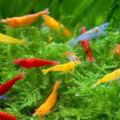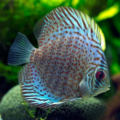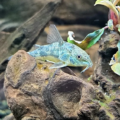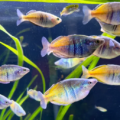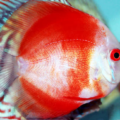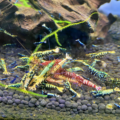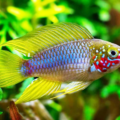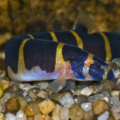Explore our ultimate guide to Heckel Discus care. This guide is loaded with tips on healthy feeding, tank setup, breeding, and extending their lifespan; everything to help you become the best Discus aquarist!

Introduction
Let’s start with a brief overview of the Heckel Discus.
The Heckel Discus is a stunning Amazonian discus species discovered in the gently flowing waters of the Amazon River Basin. This freshwater beauty is famous for its vibrant colors and eye-catching vertical pattern featuring bold black stripes that run through the center of its body.
This striped discus is a perfect pick for aquarists who enjoy the sight of natural and wild discus varieties in their homes. However, keeping this fish is only the start of a challenging but rewarding cycle.
From wild-caught discus care to feeding instructions, breeding tips, tank setup, and disease prevention, our guide has all the helpful tips to help you experience a seamless journey.
Unveiling the Striking Appearance of Heckel Discus
Need help identifying wild discus? Hold that thought!
The Heckel Discus is endowed with blinding beauty and peculiar features, making it a must-have in a tank of Amazonian fish species.
Color Pattern: The Heckel Discus stripe patterns and natural hues provide a striking beauty, camouflage, and protective purpose for it in the wild. These tones of blue, red, and green often vary in intensity due to environmental conditions.
Unique Traits: The wild Heckel Discus fish carries special Amazonian fish features in homage to its roots. The fish comes with a bold, dominant black stripe running through the middle of its body that can’t be found on any other wild-type discus.
Creating an Authentic Habitat for Heckel Discus

Recreating an Amazon-inspired aquarium, which is the natural environment of the Heckel Discus, is crucial to providing the ideal conditions for this wild discus to survive and breed.
In a Heckel Discus tank setup, soft, acidic water and a spacious, well-structured tank must be prioritized.
| Tank Size | start with 75 gallons for a small group of wild discus and go higher depending on the size you’re working with. |
| Water Temperature & Softness | 82–86°F, 1-4 dGHHowever, Wild Discus prefers water temperatures reaching 90°F |
| pH Level | 5.5-6.5 |
| Filtration Requirements | A sponge filter ensures gentle filtration for pure water and curbs strong water currents. |
Discus Aquascaping Ideas
It’s time to seal the deal by introducing some natural decor into your tank.
- Place some driftwood in the tank to create hiding spots, harness the tannin secretion to naturally reduce pH, and give your tank water a tea-stained look.
- Introduce leaf litter to mimic the surroundings of their natural Amazonian habitat.
- Use low lighting to mirror the streaked sunlight of their natural habitat. This will eliminate stress and keep their colors sharp.
- Add dark substrates to your tank to enhance the color contrast.
Feeding Heckel Discus: Diet Essentials for Vibrant Health

Heckel Discus are typically omnivorous. This means they consume 80–90% live frozen food, vegetables, and high-quality prepared food. Feeding wild discus fish a balanced diet enhances their natural colors and overall vitality.
Diet Suggestions: A healthy diet for discus fish should include blackworms, daphnia, blanched vegetables, and spirulina-enriched flakes.
Feeding Schedule: Overfeeding is a no-go area when feeding wild discus. You should only feed them twice daily with small portions of defrosted food spread throughout the tank. Clear the leftovers from the tank as soon as they’re done with consumption.
For more on feeding your aquatic pets check out The Ultimate Guide to Fish Food: Pros and Cons & Best Choices!
Breeding Heckel Discus: Challenges and Strategies

Breeding wild Heckel Discus is not a walk in the park due to their preference for specific water conditions and the challenges of replicating the conditions in their natural Amazonian habitat in home tanks.
Breeding Conditions: Keep the breeding water soft and acidic with a pH between 5.0–6.5 and a hardness of 0–3 dGH. The ideal temperature for reproduction in discus fish should be stable at 84–86°F for a natural spawning process.
Tank Isolation: Move the bonded pair to a designated fish tank for breeding to keep them safe and away from stressful conditions. Don’t forget to add spawning surfaces like driftwood, broad leaves, and rock surfaces to the tank. Refer here for more info.
This video has been very helpful in identifying the sex of Discus fish, I highly recommend it:
Discus Fry Care Tips
- Get your fish fry on crushed fish pellets a week after feeding on their parents’ mucus coating to aid faster growth.
- Avoid overfeeding your juvenile Heckel Discus fish, as the excess waste passed can contaminate your water and lead to diseases.
- Perform mild water changes between 15-25% for waste discharge without discomforting the fry.
Author’s note: The best result is obtained when you let the pairing occur organically rather than force a bond between two Heckel Discus.
Ideal Tank Mates for Heckel Discus

Selecting the right tank mates for Heckel Discus is beneficial to sustaining a peaceful and stress-free environment. This striped patterned fish cohabitates well with similarly shaped and peaceful aquarium species as tank partners, requiring the same water parameters, nutritional setup, and feeding schedules.
Compatible Species: Clown Pleco, Neon Tetras, Corydoras Catfish, Bolivian Ram, Rainbow Fish, Clown Loaches, and other small freshwater Amazonian species are great community fish for wild discus.
Incompatible Species: Avoid pairing Heckel Discus with aggressive or territorial fish to maintain a serene environment. Tiger Barbs, Large Cichlids, Danios, Large Tetras, Goldfish, and Large Cold-Water fishes should not be added to your tank to prevent creating hostile, harmful, and stressful conditions.
Preventing Common Health Issues in Heckel Discus
Heckel Discus are very sensitive to changes in water quality and their tank environment, making them susceptible to stress, gill flukes, and fungal infections. Proper care, consistent water quality, and early detection of symptoms are vital for maintaining wild discus health.
Signs of illness: As a Heckel Discus aquarium owner, you must take note of the following symptoms as part of Heckel Discus health care:
1. Labored Breathing
2. Discoloration or Fading Colors
3. Rubbing Against Surfaces
4. Lethargy and Reduced Appetite
Preventing aquarium diseases
This process is all about dotting the I’s and crossing the essential T’s.
- Perform about 50% regular water changes to eliminate toxic chemicals and keep water conditions stable.
- Quarantine new additions for about 21 days before introducing them to the tank.
- Promptly evacuate leftover food to prevent water contamination.
- Don’t overcrowd your tank to avoid stressing your Heckel Discus fish.
For more details on white-spot illness, or ich, which pose a threat to discus checkout our article on How to Treat Ich Outbreaks in Your Freshwater Fish!
Extending the Lifespan of Heckel Discus

As wild-caught species, Heckel Discus are sensitive to changes, requiring long-term discus care to survive the completely different environment of aquariums.
The good news is they can live up to 10–15 years in captivity, but the longevity of Heckel Discus’s lifespan depends on multiple conditions, including providing a balanced diet, minimizing stress, and infusing natural properties into their tanks. Check here for more.
Care Tips For Longevity
- Take regular maintenance seriously, including frequent water changes and stable water parameters.
- Quarantine new fish before adding to the tank to curb disease spread.
- Caring for wild discus can be rewarding when you do it the right way. Always be on the watch for early symptoms of illness, as indicated here.
Conclusion: Caring for Heckel Discus with Confidence
This wild species is ideal for intermediate to advanced aquarists. However, you must never forget that maintaining a Heckel Discus tank demands rapt attention to water quality and a stable environment.
Our Heckel Discus guide will help you gain the knowledge to help this exquisite Amazonian discus species unleash their full potential in your aquarium. Whether you’re new to wild-caught discus care or an experienced aquarist, the wild discus care tips in this post will make your experience worthwhile.

